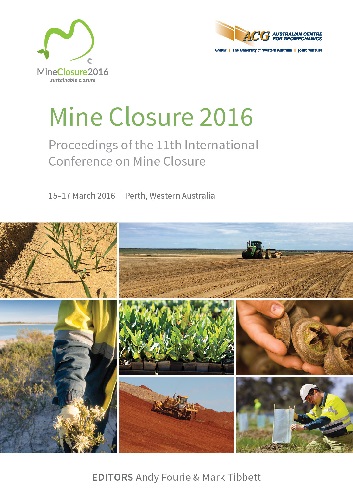Slope stability in landform design

|
Authors: Knutsson, R; Bjelkevik, A; Knutsson, S Paper is not available for download Contact Us |
DOI https://doi.org/10.36487/ACG_rep/1608_03_Knutsson
Cite As:
Knutsson, R, Bjelkevik, A & Knutsson, S 2016, 'Slope stability in landform design', in AB Fourie & M Tibbett (eds), Mine Closure 2016: Proceedings of the 11th International Conference on Mine Closure, Australian Centre for Geomechanics, Perth, pp. 89-98, https://doi.org/10.36487/ACG_rep/1608_03_Knutsson
Abstract:
Tailings storage facilities (TSFs) will, after closure of the mine, have to be stable in a long-term perspective (e.g. 1,000 years or more). In many cases, due to the characteristics of the tailings, a high phreatic surface is required to keep the tailings saturated in order to prevent, or minimise, the process of oxidation. Due to this the slope stability of the embankment, or the land form slope, is critical as any material exposed to a hydraulic gradient is exposed to a load. So, the question is: Is the embankment, or landfill slope, that is exposed to a hydraulic gradient safe in the long term with respect to the actual design and material properties? In order to answer that question, an understanding of the structure, its stability and level of actual safety during operation is necessary. This paper will therefore discuss slope stability for embankments during operation and the long-term perspective and how the factor of safety (FS) can be verified. Practice today for dam stability is that a certain FS is required, i.e. a safety margin (in Sweden FS>1.5), and for that condition we design the embankment. The design includes the geometry of the structure, material properties, water management/water levels and requirements for compatibility between different materials, as well as for construction and operation. The FS can, however, not be physically measured on, or in, the actual embankment. What can be measured is seepage, pore pressure and movement (vertical and horizontal displacements). But how can the readings be used to verify the actual FS? In order to illustrate this, an example from a TSF in northern Sweden is presented where readings have been taken through numerical modelling (PLAXIS), comprehensive geotechnical investigations, lab testing and inclinometers. In order to predict how an embankment, or landform slope, will behave in the long-term phase and what the actual FS will be, the authors believe it is necessary to understand the behaviour of the structure during operation. The method used for the example illustrated in this paper shows a method to gain an understanding for a structure, which is absolutely crucial for understanding the actual FS and for the possibility to predict the level of safety in the long term.
Keywords: tailings management facility, slope stability, factor of safety, landform design, long term
References:
Bhanbhro, R 2013, Oedometer tests – Aitik tailings dam (internal working document), Luleå University of Technology, Luleå, Sweden.
Bhanbhro, R, Knutsson, R, Rodriqguez, JM, Edeskär, T & Knutsson, S 2013, ‘Basic Description of Tailings from Aitik Focusing on Mechanical Behavior’, International Journal of Emerging Technology and Advanced Engineering, vol. 3, no. 12, pp. 65–69.
Brinkgreve, R, Enging, E & Swolfs, W 2014, PLAXIS user’s manual, Delft, The Netherlands.
Dunnicliff, J 1988, Geotechnical instrumentation for monitoring field performance, Wiley, New York.
GruvRIDAS 2012, Gruvindustrins riktlinjer för dammsäkerhet, Svensk Energi AB/SveMin, Stockholm, Sweden (in Swedish).
ICOLD (International Commission on Large Dams) 1996, ‘Monitoring of tailings dams’, ICOLD Bulletin 104, Paris.
ICOLD (International Commission on Large Dams) 2011, ‘Improving tailings dam safety’, ICOLD Bulletin 139, Paris.
Jonasson, F 2013, Geotekniska undersökningar, dam G-H och E-F, tolkning av geotekniska förhållanden samt utvärdering av portryck och rörelse I dammen, Uppdragsnummer 2168072800 (internal report), Sweco Infrastructure AB, Stockholm, Sweden (in Swedish).
Knutsson, R 2013, Triaxial tests – Aitik tailings dam (internal working document), Luleå University of Technology, Luleå, Sweden.
Marcato, G, Mantovani, M, Pasuto, A, Zabuski, L & Borgatti, L 2012, ‘Monitoring, numerical modelling and hazard mitigation of the Moscardo landslide (Eastern Italian Alps)’, Engineering Geology, vol. 128, pp. 95–107.
Ostoprak, S & Cinicioglu, SF 2005, ‘Soil behaviour through field instrumentation’, Canadian Geotechnical Journal, vol. 42, pp. 475–490.
Schanz, T, Vermeer, P & Bonnier, P 1999. ‘The hardening soil model: Formulation and verification’, Proceedings of the International Symposium beyond 2000 in Computational Geotechnics, Amsterdam, pp. 281–296.
Sweco VBB 2008, Förslag på materialparametrar för “Övriga material” vid beräkning i PLAXIS (internal report), SWECO VBB, Luleå, Sweden (in Swedish).
Vahdati, P, Levasseur, S, Mattsson, H & Knutsson, S 2013, ‘Inverse Mohr-Coulomb soil parameter identification of an earth and rockfill dam by genetic algorithm optimization’, Electronic Journal of Geotechnical Engineering, vol. 18, no. X, pp. 5419–5440.
Yin, Y, Wang, H, Gao, Y & Li, X 2010, ‘Real-time monitoring and early warning of landslides at relocated Wushan Town, the Three Gorges reservoir, China’, Landslides, vol. 7. pp. 339–349.
© Copyright 2025, Australian Centre for Geomechanics (ACG), The University of Western Australia. All rights reserved.
View copyright/legal information
Please direct any queries or error reports to repository-acg@uwa.edu.au
View copyright/legal information
Please direct any queries or error reports to repository-acg@uwa.edu.au